As a non-native English speaker from a not-so-popular language group, learning to read even casual science stuff was an uphill battle. First I had to learn English to a reasonable level. Then I realized that English-Romanian dictionaries hadn’t really kept up with science.
I eventually managed to get my hands on a fancy English-only dictionary (yes, a printed one, this was a while ago), but then I ran into another problem: I'd start from one definition, only to find another unfamiliar word in the explanation, then another one in that definition and so on, until I forgot where I had started. And even when I did understand a concept, I'd often be stuck with the English word and with a lot of frustration about trying to convey that in my own language.
Some of those struggles are outdated now. At least you no longer have to deal with a giant dictionary pressing into your ribs if you’re reading lying down. But the language gap in science communication still exists.
That’s why I’m launching a community project: The brain across languages.
We’re inviting students who speak more than one language to help us translate Neurofrontiers content into as many languages as possible.
If you’re interested (or know someone who might be), details here: https://neurofrontiers.blog/the-brain-across-languages/
Boosts are very much appreciated!
#neuroscience #SciComm #scienceOutreach #science #language #multilingual




